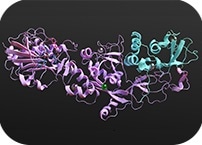When cells in the human body are invaded by a virus, they send a signal to adjacent cells to boost their antiviral defenses to stop the spread of infection. But some viruses manage to evade this system by imitating the host’s RNA, preventing them from being identified by the infected cell and thus avoiding this alert.

Interfering with nsp14 binding and with the nsp10-nsp14 protein complex is the aim of the most recent ITQB NOVA research in COVID-19. Image Credit: ITQB NOVA.
With regard to SARS-CoV-2, this mimicking mechanism utilizes a protein called nsp14. Such a protein is also crucial for virus replication—a task which is aided by its binding to the nsp10 protein, leading to a protein complex.
The goal of the most recent study on COVID-19, performed by Instituto de Tecnologia Química e Biológica António Xavier (ITQB NOVA) and headed by researchers Margarida Saramago, Rute Matos, and Ceclia Arraiano, is to interfere with the nsp14 binding and the nsp10-nsp14 protein complex.
The investigators first conducted the biochemical characterization of the nsp10-nsp14 protein complex, a familiar therapeutic target.
“For the first time, it was possible to identify the amino acids which must be targeted in order to silence this complex,” Rute Matos explained.
The silencing of nsp14 also makes it easier for the organism to identify the virus' messenger RNA and to activate the immune system before it replicates.”
Margarida Saramago, Fellow Researcher, ITQB NOVA, Universidade Nova de Lisboa
The finding was made possible by the association between scientists from an experimental RNA laboratory and researchers from the bioinformatics field, who collectively worked to define the proteins. The 3D model of the nsp14-nsp10 complex was built on the corresponding SARS-Cov-1 proteins.
“It's like doing a facial composite. With a very clear notion of the shape of the protein, it was possible to predict the most important amino acids,” said bioinformatician Caio Souza, who designed the model.
With a very clear concept of the protein shape, the most significant amino acids could be predicted.
“We have a very detailed map of the target we must attack with future therapies,” stated Diana Lousa, fellow bioinformatician and the co-author of the study.
By silencing this protein, we will be able to ‘domesticate’ a severe disease and turn it into a cold. It's as if we turned a wolf into a dog.”
Cecilia Arraiano, ITQB NOVA, Universidade Nova de Lisboa
Arraiano is also the leader of one of the two laboratories involved.
This understanding can now be applied to create antivirals, a project which is currently being performed by the researchers.
Even with the hope of vaccines, it is essential to identify therapies capable of treating the infections that will continue to occur. This type of research must be funded by public institutions.”
Cláudio M. Soares, Study Co-Author and Director, ITQB NOVA, Universidade Nova de Lisboa
The Federation of European Biological Societies (FEBS) has approved the research paper for publication in The FEBS Journal.
Source:
Journal reference:
Saramago, M., et al. (2021) New targets for drug design: Importance of nsp14/nsp10 complex formation for the 3’‐5’ exoribonucleolytic activity on SARS‐CoV‐2. The FEBS Journal. doi.org/10.1111/febs.15815.